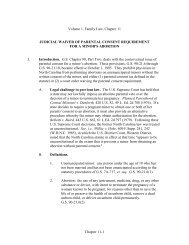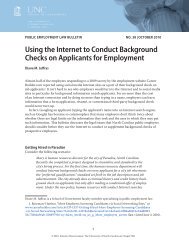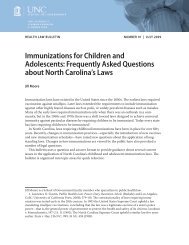Sentencing, Corrections, Prisons, and Jails - School of Government ...
Sentencing, Corrections, Prisons, and Jails - School of Government ...
Sentencing, Corrections, Prisons, and Jails - School of Government ...
Create successful ePaper yourself
Turn your PDF publications into a flip-book with our unique Google optimized e-Paper software.
<strong>Sentencing</strong>, <strong>Corrections</strong>, <strong>Prisons</strong>, <strong>and</strong> <strong>Jails</strong> 237<br />
total compensation that can be paid apart from allowable funeral expenses (the previous limit was<br />
$20,000).<br />
Rape Victims’ Assistance<br />
G.S. Chapter 143B, Article 11, Part 3A, enacted in 1981, establishes a program <strong>of</strong> assistance for<br />
victims <strong>of</strong> rape <strong>and</strong> sex <strong>of</strong>fenses. This program covers only victims who have reported the crimes <strong>of</strong><br />
first- or second-degree rape or first- or second-degree sexual <strong>of</strong>fense to law enforcement authorities<br />
within seventy-two hours. (In North Carolina law, first-degree <strong>and</strong> second-degree sexual <strong>of</strong>fenses are<br />
forcible sexual acts other than vaginal intercourse.) G.S. 143B-480.2 authorizes the Secretary <strong>of</strong> Crime<br />
Control <strong>and</strong> Public Safety to pay expenses incurred by the victim, but only for immediate, short-term<br />
medical care <strong>and</strong> ambulance <strong>and</strong> mental health services. The money is paid to the health care or service<br />
provider.<br />
S.L. 1998-212, Section 19.4(n), effective December 1, 1998, <strong>and</strong> applicable to injuries on or after<br />
that date, raises the amount that may be paid under this program, from $500 to $1,000, <strong>and</strong> authorizes<br />
payment up to $50 to replace victims’ clothing held for evidence tests.<br />
<strong>Jails</strong><br />
Use <strong>of</strong> <strong>Jails</strong> for Juvenile Detention<br />
The juvenile justice reform legislation, S.L. 1998-202 (S 1260), which is described in detail<br />
Chapter 13 (Juvenile Law), has some implications for jails (confinement facilities operated by local<br />
governments). Under new G.S. 147-33.42(2), effective January 1, 1999, the new Office <strong>of</strong> Juvenile<br />
Justice may plan with any county that has space within its county jail system to use the existing space<br />
for a juvenile detention home when needed, if the space meets state st<strong>and</strong>ards under G.S. 153A-221.<br />
Juveniles confined in a jail must be supervised closely, <strong>and</strong> there must be “sight <strong>and</strong> sound separation<br />
between the juveniles <strong>and</strong> adult detainees” (i.e., the space must be designed so that juveniles will not be<br />
able to converse with, see, or be seen by the adult population). S.L. 1998-202 also amends G.S. 153A-<br />
218 to make clear that a juvenile detention facility may be located in the same building as a county jail<br />
provided that it meets the requirements <strong>of</strong> G.S. Chapter 153A, Article 10, Part 2, which include (in<br />
G.S. 153A-221.1) the requirement <strong>of</strong> sight <strong>and</strong> sound separation.<br />
Stevens H. Clarke













